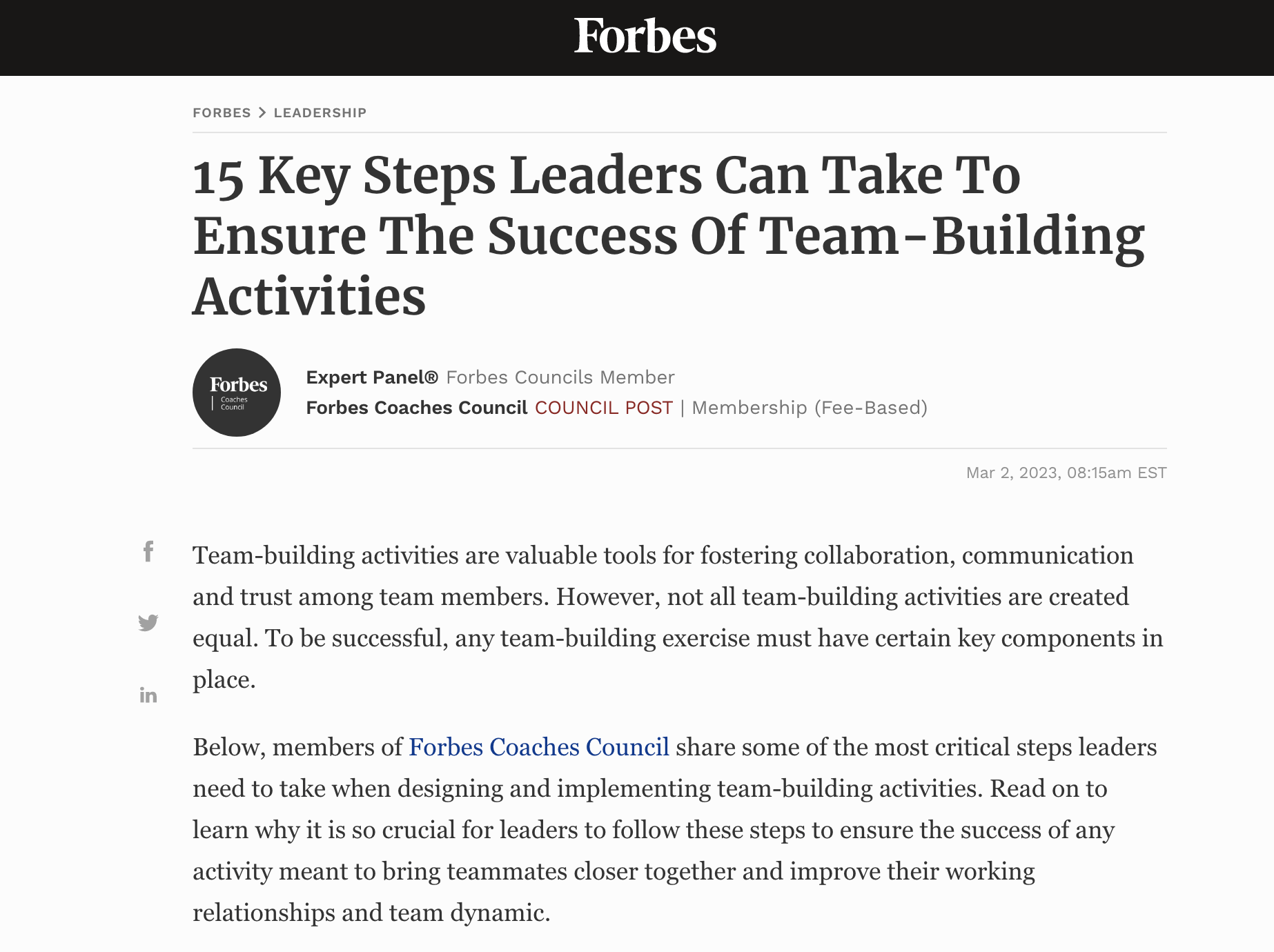Team-building activities are valuable tools for fostering collaboration, communication and trust among team members. However, not all team-building activities are created equal. To be successful, any team-building exercise must have certain key components in place.
Below, members of Forbes Coaches Council share some of the most critical steps leaders need to take when designing and implementing team-building activities. Read on to learn why it is so crucial for leaders to follow these steps to ensure the success of any activity meant to bring teammates closer together and improve their working relationships and team dynamic.
1. Don’t Treat Team Building As A One-Off Effort
Often, team-building activities do not lead to the anticipated outcomes because they are treated as special, one-day-only events. For a team to truly come together, the foundational principles of team cohesion—trust, candor and a clear understanding of roles, responsibilities and shared goals—need to be present in all interactions. If you make that the norm, team-building activities will be more impactful. – Stacy Campesi, OKA (Otto Kroeger Associates)
2. Create A Safe Environment
A key component of team-building activities is to have in place a safe environment for psychological safety. This includes three dimensions: inclusion and a sense of belonging, rules of the game, and trust and openness. Ensuring this safety will allow everyone to express themselves without fear of negative consequences impacting their image or their career. This psychological safety is a sine qua non (an essential condition) for fostering strong team dynamics. – Catherine Tanneau, Activision Coaching Institute
3. Listen To The Voice Of The Team
View the team as the client, not as a collection of individual clients. Two helpful approaches are to remind yourself that “the team is the client”—not a collection of individuals—and ask, “What is the voice of the team (not the individual voices) saying?” Viewing the team from a systems perspective can result in a new level of listening and awareness. – Robert Turner, Executive Coach Turner
4. Gather The Team’s Input Up Front
When team members and leaders feel that they are being heard individually and that their opinions are valued, they are more likely to be invested in the team-building process and see it as a valuable use of their time. In addition, this ensures that team-building activities align with both the leader’s and the team members’ goals, interests and needs. – Felice Tilin, GroupWorksConsulting LLC
5. Build Trust By Getting To Know The Team
Trust and acceptance are the foundation of teamwork, and knowing one another well and deeply is critical to building trust and acceptance. The fewer blind spots within the team, the greater the acceptance will be—and that facilitates trust-building and faster success in team building activities. – Anilkumar G, ACTIONRICH Business Solutions India Pvt Ltd.
6. Cultivate A Sense Of Openness
For truly effective team building, there needs to be openness. Often, team members look at these activities as a “check the box” exercise or another cheesy event, but when they have an open mind, open heart and open perspective, the results are significant. Encourage your team to be open to the process, relax, have fun and trust that the work they do together will pay off in the future. – Tami Chapek, WeInspireWe
7. Help The Team Get To Know Each Other As Individuals
Since teams are built by individuals, before engaging in team-building activities, it’s helpful for the group to better understand each individual. One excellent method that gets the ball rolling is to ask each person to have another person on the team introduce them. In other words, start the process “smaller” by creating one-on-one engagement. – Ben Levitan, Cedalion Partners
8. Emphasize The Purpose, Value And Mission Of The Team
Team members need to understand the purpose, value and mission of the team for team-building to be successful. They have to understand how they fit in and that their purpose as a member of the team goes beyond their own role—they should contribute as a “team” member, not just as a member of their role. – Rochelle Cooper, Success Leaders
9. Demonstrate Vulnerability, And Laugh Together
To unite people, you need to build an environment of trust. If you share your vulnerable experiences, people will feel that you trust them and that they can trust each other. Then, you can move on to fun activities or “sharing about yourself” exercises. When people share something fun and/or personal, they grow closer, because nothing unites better than trust and common laughter. – Aina Alive, Bee Agile
10. Foster An Open Mindset
An open mindset is core to the success of team building. It is indicative of a willingness to learn, to take risks and accept failure as part of growth. Openness suggests trust and a desire for change, while appreciating the diversity of thought and creativity that true team building can stimulate. Those with an open mindset are self-aware and know that excellence happens through team synergy. – Susan Murray, Clearpath Leadership
11. Help Teammates Learn How To Effectively Communicate
As important as communicating clarity, expectations, respect and many other values may be, that is not what I am talking about. Helping the team members understand everyone’s different communication styles and how to hear each other better is what will make the biggest impact during the team-building activities. – Lillit Cholakian, NewGen Global Leaders
12. Make Sure The Activity Is Business-Relevant
All team-building events must be business-relevant. Leaders must include a way for the team to take collective action to solve a business problem or achieve a business goal, whether it’s simply to prioritize what’s already on their plate or to remove one obstacle in the way of their cohesion or forward progress. Otherwise, team building is just a “feel-good” moment that the participants will quickly forget. – Claire Chandler, Talent Boost
13. Show How It Aligns To Teams’ Day-To-Day Work
These exercises can be very effective at skill-building, raising awareness and developing team dynamics, but professionals also need to understand how this will help them individually and collectively as a team when they get back to the task at hand. It cannot just be an “interesting” exercise. – Nikki Moberly, Big Breakthroughs
14. Establish Agreements Around What Success Looks Like
One key component of team-building activities is the establishment of community agreements around what success will look like at the end of the activity. Have you ever been told in a team exercise that “this is a safe space”? That is an assumption that should not be made without properly establishing the agreements that will guide and help each member show up in an authentic way. – Lawrence Henderson, BOSS Consulting
15. Make Sure Team-Building Activities Are Not Cheesy
The one thing team-building activities cannot be is cheesy! Leaders should reframe such events as “relationship-building” activities and intentionally design genuine and authentic avenues for their teams to build relationships with each other. By focusing on relational activities, leaders enable a collection of individuals to come together as a cohesive team who will generate results. – Robin Pou, The Confident Leader



